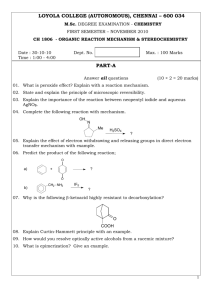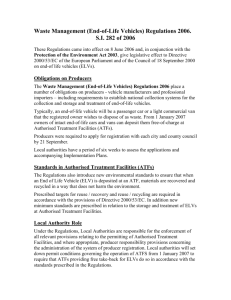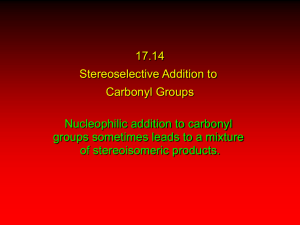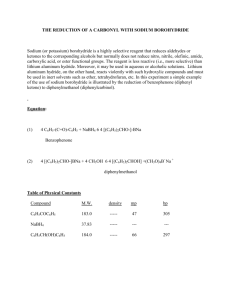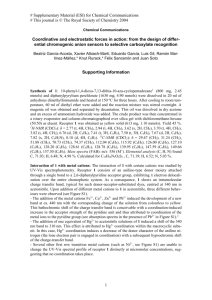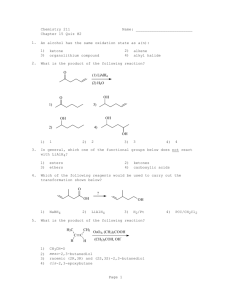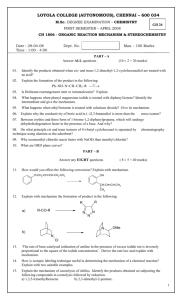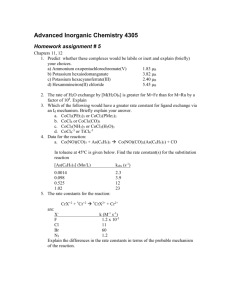Organic Chemistry Fifth Edition
advertisement
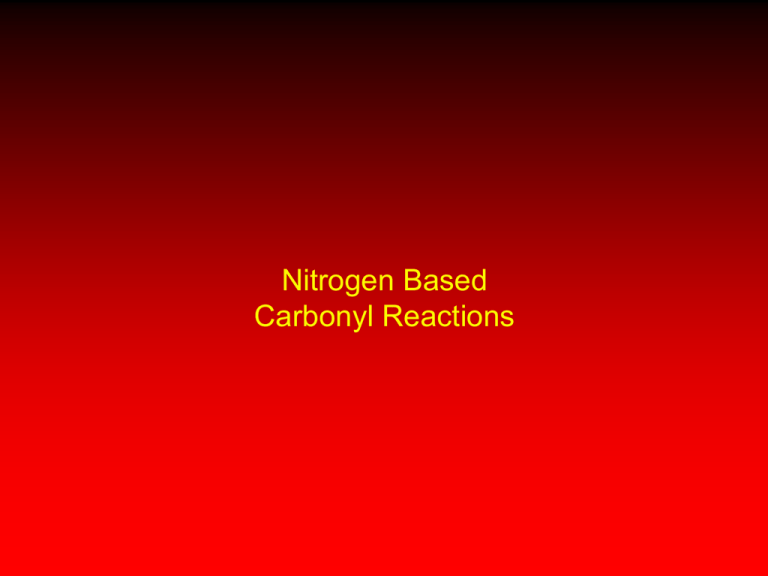
Nitrogen Based Carbonyl Reactions Some reactions of aldehydes and ketones progress beyond the nucleophilic addition stage Acetal formation Imines Compounds related to imines Enamines The Wittig reaction Enamine from 2o amines Question • The compound below is best classified as a(n) (CH3)3CCH2CH=NCH3 • • • • A) B) C) D) carbinolamine. enamine. hydrazone. imine. Question • Identify the product isolated when cyclopentanone reacts with dimethyl amine. • A) B) • C) D) The Wittig Reaction Some reactions of aldehydes and ketones progress beyond the nucleophilic addition stage Acetal formation Imine formation Compounds related to imines Enamines The Wittig reaction The Wittig Reaction Synthetic method for preparing alkenes. One of the reactants is an aldehyde or ketone. The other reactant is a phosphorus ylide. + (C6H5)3P – C •• A A (C6H5)3P B C B A key property of ylides is that they have a negatively polarized carbon and are nucleophilic. Charge distribution in a ylide The Wittig Reaction R C •• + O •• + (C6H5)3P – C •• B R' R A C R' A + C B + (C6H5)3P •• – O •• •• Example •• O •• + + (C6H5)3P – CH2 •• DMSO CH2 + + (C6H5)3P •• – O •• •• (86%) dimethyl sulfoxide (DMSO) or tetrahydrofuran (THF) is the customary solvent Mechanism Step 1 R R C •• O •• •• R' C O •• A C P(C6H5)3 R' A B •• C – + P(C6H5)3 B Mechanism Step 2 R R R' C •• R' C O •• A C P(C6H5)3 + C A •• – •• O •• B P(C6H5)3 + B Alkene Synthesis via the Wittig Reaction Retrosynthetic Analysis R A C R' C B There will be two possible Wittig routes to an alkene. Analyze the structure retrosynthetically. Disconnect the doubly bonded carbons. One will come from the aldehyde or ketone, the other from the ylide. Retrosynthetic Analysis of Styrene O C6H5CH + C6H5CH + (C6H5)3P CH2 – CHC6H5 •• + •• Both routes are acceptable. O + (C6H5)3P – CH2 HCH Preparation of Ylides Ylides are prepared from alkyl halides by a two-stage process. The first step is a nucleophilic substitution. Triphenylphosphine is the nucleophile. A A (C6H5)3P •• + CH X + (C6H5)3P B CH B + X– Preparation of Ylides In the second step, the phosphonium salt is treated with a strong base in order to remove a proton from the carbon bonded to phosphorus. + (C6H5)3P – C •• A A + (C6H5)3P B base H C B – base •• H Preparation of Ylides Typical strong bases include organolithium reagents (RLi), and the conjugate base of dimethyl sulfoxide as its sodium salt [NaCH2S(O)CH3]. + (C6H5)3P – C •• A A + (C6H5)3P B base H C B – base •• H Question • Select the product isolated when butanal reacts with the slide shown below. • A) B) • C) D) Question What is the produc t of the reaction sequence below? A. B. C. D. 2-methyl -1-hexene 2,3-dimethyl -2-pentene 2-methyl -2-hexene 3-methyl -1-hexene Stereoselective Addition to Carbonyl Groups Nucleophilic addition to carbonyl groups sometimes leads to a mixture of stereoisomeric products. H3C Example CH3 O H3C CH3 H3C CH3 NaBH4 OH H OH H 80% 20% Steric Hindrance to Approach of Reagent This methyl group hinders approach of nucleophile from top. – H3B—H Preferred direction of approach is to less hindered (bottom) face of carbonyl group. Biological Reductions are Highly Stereoselective pyruvic acid S-(+)-lactic acid CO2H O CH3CCO2H NADH HO H H+ CH3 Enzyme is lactate dehydrogenase Figure 1 One face of the substrate can bind to the enzyme better than the other. Figure 2 Change in geometry from trigonal to tetrahedral is stereoselective. Bond formation occurs preferentially from one side rather than the other. Oxidation of Aldehydes Example O O CH O K2Cr2O7 H2SO4 H2O O COH (75%) Baeyer-Villiger Oxidation of Ketones Oxidation of ketones with peroxy acids gives esters by a novel rearrangement. General O O RCR' + R"COOH Ketone O O ROCR' + R"COH Ester Example O O CCH3 O C6H5COOH CHCl3 OCCH3 (67%) Oxygen insertion occurs between carbonyl carbon and more substituted group. Methyl ketones give acetate esters. Stereochemistry O O O CCH3 H3C H H C6H5COOH CHCl3 OCCH3 H3C H H (66%) Reaction is stereospecific. Oxygen insertion occurs with retention of configuration. Mechanism O O O RCR' + R"COOH First step is nucleophilic R addition of peroxy acid to the carbonyl group of the ketone. O ROCR' + R"COH O H C R' O OCR" O Mechanism O O O RCR' + R"COOH Second step is migration R of group R from carbon to oxygen. The weak O—O bond breaks in this step. O ROCR' + R"COH O H C R' O OCR" O Biological Baeyer-Villiger Oxidation bacterial oxidation O O 2. cyclohexanone monooxygenase, coenzymes O Certain bacteria use hydrocarbons as a source of carbon. Oxidation proceeds via ketones, which then undergo oxidation of the Baeyer-Villiger type. O Question • What is the product of the following Baeyer-Villiger oxidation reaction?
